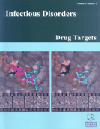- Home
- A-Z Publications
- Infectious Disorders - Drug Targets (Formerly Current Drug Targets - Infectious Disorders)
- Previous Issues
- Volume 13, Issue 3, 2013
Infectious Disorders - Drug Targets (Formerly Current Drug Targets - Infectious Disorders) - Volume 13, Issue 3, 2013
Volume 13, Issue 3, 2013
-
-
Traffic in the Operating Room: A Review of Factors Influencing Air Flow and Surgical Wound Contamination.
More LessAuthors: Marian Pokrywka and Karin ByersSurgical wound contamination leading to surgical site infection can result from disruption of the intended airflow in the operating room (OR). When personnel enter and exit the OR, or create unnecessary movement and traffic during the procedure, the intended airflow in the vicinity of the open wound becomes disrupted and does not adequately remove airborne contaminants from the sterile field. An increase in the bacterial co Read More
-
-
-
Role of Infection Control in Prevention of Hepatitis B virus (HBV) in Hemodialysis (HD) Patients.
More LessAuthors: Mohamed H. Yassin and Vineet GuptaHemodialysis (HD) patients are particularly vulnerable to Hepatitis B virus (HBV) and have less sustained and lower antibody response to HBV vaccination. Among blood-borne pathogens, HBV can stay alive on environmental surfaces for over a week. The incidence of HBV was extremely high among HD patients. HBV vaccination, screening of blood products and infection control measures lead to significant decrease of H Read More
-
-
-
Sustainable Hand Hygiene Efforts; a Review of a Successful Campaign.
More LessAuthors: Juliet Ferrelli and Marge Hardt DiCuccioAim: The aim of this paper is to provide a review of the hand hygiene literature and to give an example of the use of this literature to create a multimodal sustainable hand hygiene program. Background: The literature describes six key ingredients to consider when designing a hand hygiene program. These ingredients include leadership engagement, environmental assessment, education, a tight feedback loop, communicati Read More
-
-
-
Opening Pandora's (Tool) Box: Health Care Construction and Associated Risk for Nosocomial Infection.
More LessAuthors: Jeffrey D. Clair and Sandie ColatrellaThere are approximately 5,700 hospitals in the United States, 3,000-4,000 that are antiquated or obsolescing. To meet increased service demands, remain financially viable; meet needs to upgrade aging infrastructure and incorporate medical and technology advancements, healthcare facilities are in a perpetual state of construction. Outbreaks of nosocomial infections have historically been documented in association with const Read More
-
-
-
Monochloramine Use for Prevention of Legionella in Hospital Water Systems.
More LessAuthors: Sheetal Kandiah, Mohamed H. Yassin and Janet StoutEradication of Legionella species from water distribution systems especially in hospital settings has proven to be challenging. Legionella species causes Legionnaire’s disease that is a potentially fatal respiratory disease often acquired through the aerosolization of contaminated water. Monochloramine has been used successfully in the municipal water systems to eradicate Legionella and there is currently limited data t Read More
-
-
-
Role of Ultraviolet (UV) Disinfection in Infection Control and Environmental Cleaning
More LessAuthors: Zubair Qureshi and Mohamed H. YassinUltraviolet (UV) radiation is capable of disinfecting surfaces, water and air. The UV technology was used for many years. However, safer and more effective delivery systems of UV radiation, make it a very useful option for disinfection. Effective disinfection of environmental surfaces is a key step in the prevention of spread of infectious agents. The traditional manual cleaning is essential in assuring adequate elimination of contami Read More
-
-
-
Infection and Hemodialysis Access: An Updated Review
More LessAuthors: Vineet Gupta and Mohamed H. YassinThe incidence of end-stage renal disease (ESRD) has almost doubled over past 2 decades. Despite decreasing overall hospital admission rates for ESRD population, the rate of infection-related hospitalizations has steadily increased. Infection remains the second most common cause of mortality in this patient population. Specifically, in the hemodialysis (HD) patients, the vascular access related infections are the most co Read More
-
-
-
Role of Toxicogenomics in the Development of Safe, Efficacious and Novel Anti-microbial Therapies.
More LessOver the last two decades, occurrence of bacterial resistance to commonly used antibiotics has necessitated the development of safer and more potent anti-microbial drugs. However, the development of novel antibiotics is severely hampered by adverse side effects, such as drug-induced liver toxicity. Several antibacterial drugs are known to have the potential to cause severe liver damage. The major challenge in developi Read More
-
Volumes & issues
-
Volume 25 (2025)
-
Volume 24 (2024)
-
Volume 23 (2023)
-
Volume 22 (2022)
-
Volume 21 (2021)
-
Volume 20 (2020)
-
Volume 19 (2019)
-
Volume 18 (2018)
-
Volume 17 (2017)
-
Volume 16 (2016)
-
Volume 15 (2015)
-
Volume 14 (2014)
-
Volume 13 (2013)
-
Volume 12 (2012)
-
Volume 11 (2011)
-
Volume 10 (2010)
-
Volume 9 (2009)
-
Volume 8 (2008)
-
Volume 7 (2007)
-
Volume 6 (2006)
Most Read This Month
Article
content/journals/iddt
Journal
10
5
false
en


